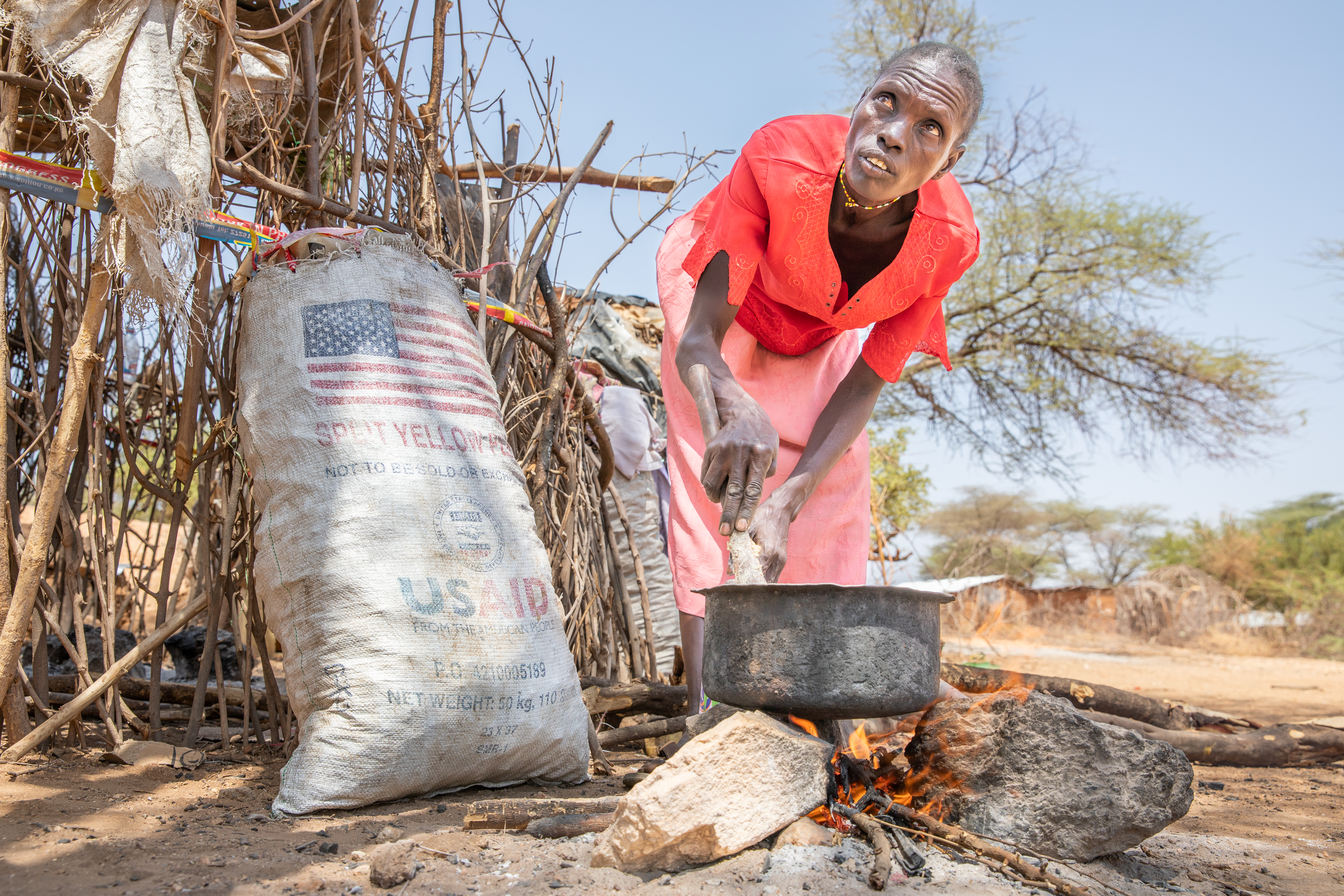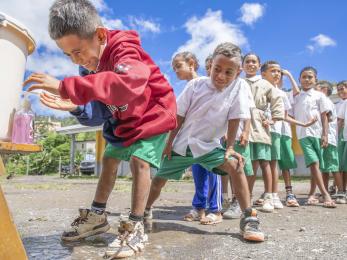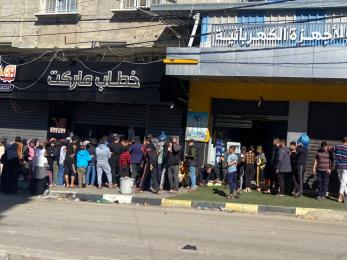The hidden survivors of the hunger gap

The drive to Hajia’s village tells the story. Out the window, miles of papery millet fields stretch in yellow blankets to every horizon. Millions of plants shoot out from the sand, thumping in the distance against the windshields of trucks that cut through on dusty curves.
But it is late August, and temperatures today will touch 100 degrees fahrenheit (38 celcius). It is far too early to harvest anything. Every turn through the fields reveals the paradox of life in southern Niger: food as far as you can see, and nothing anyone can eat.
Locals call it the hunger gap, a period from roughly April to September every year when food from the previous year’s harvest has run out, but the next one is not yet ready.
It’s like going thirsty at sea. Every year the spring rains move out, the dry season settles in, and millions of people living in Niger’s hidden rural communities must once again figure out how they will bridge the long months until harvest, in villages surrounded by crops they cannot touch.
“In this period, what people have harvested and stocked tends to finish,” says Zakaria, a local Mercy Corps worker who trains farmers here. “The farm work will soon start. That’s what makes it difficult, because they spend a lot of energy and have to eat more.”
Unlike natural disasters, which can be unpredictable, or droughts, which can be variable, the hunger gap is frighteningly regular. These sandy fields are part of the Sahel, an arid dividing line between desert and savannah that stretches across the belly of central Africa. It is the last breath of the Sahara, a place where every element of daily life funnels through one basic but resounding question.
What is there to eat?
How you survive the hunger gap depends on your circumstances. Whether you are married, otherwise employed, or have money saved will determine how you make it to harvest. But whatever your situation, the options are scarce.
Option one: Don't eat.

The fundamental reality for most people in the hunger gap is to go without food. Many people only eat one meal a day, or simply rely on whatever they can find, sometimes eating, but otherwise not.
This is particularly common among parents, who will sooner go without in order for their children to have food. That’s the situation for Balki, a mother of six who lives in the village of Chadawana. She is most likely to eat millet, beans and greens in a given day, though not on the day we meet.
“We don’t have anything to eat,” she says. “Even now I have to go and look for something.”
“It’s hard. It’s so hard to live in this hunger gap. You have to go out in the bush and find fodder for the animals, and then try to do other things to find food for the children. … It’s hard because we don’t have money, and we don’t have food.”
Two years ago, Mercy Corps gave Balki two red goats that provide milk for her family. With that expense gone, Balki can save her money or spend it on other necessities like clothes for her children. The goats are also an important safety net: She can sell them, or their milk, if she needs extra money.
“The two goats have changed our lives … we can give their milk to the babies and mix it with food,” she says. “[They’ll] say, ‘Mama, thank you.’”
Balki wants a better life for her children: a job that lets them build a future, a chance to leave the village behind. Maybe they will become judges, she dreams, and then she’s carried away on the vision of a day when the burden of providing enough to eat is at least a few stomachs lighter.
“When they come in the village,” she says, “I can welcome them, clapping.”
A profound lack of food is also most likely to touch widows and the elderly, who are often left to find food on their own. Rabi, a widow in the village of Garake, is one of the poorest women in her village, yet she still has several people who depend on her.
“It’s hard,” she says. “It’s a very hard period. I have no husband, I have no children. My daughter has just died. I have two orphans and other children that live with me.”
“We don’t have enough food to eat. We don’t have husbands to help us.”
Rabi works several hours a day in a garden in front of her home, alongside Haua, another village woman who has two children. Not long ago, one of Haua’s sons taught her to plant cassia, a hearty and nutritious plant that grows well here. Rabi and Haua pick the leaves together, then cook them down in an iron pot and season them with a spicy paste made from crushed nuts.
Calm and determined in the midday heat, Rabi and Haua are a picture of resilience in Niger: two women who have found in their shared circumstances a sense of community that helps get them through. This small meal together is likely the only thing they will eat today.
“When we start harvesting, there will be fewer problems,” Haua says. “I have not had any millet for five days. It will be ready in one month. The millet is not ripe, it is not ready. But in one month we can get it.”
Option two: Leave your family.

The hunger gap weighs differently on women and men. While women often assume the responsibility of caring for their families, men are charged with providing for them. That is not possible for a farmer in the lean season, which can mean a difficult but necessary decision: leaving home.
Badamasi leaves for Nigeria every year during the hunger gap. He looks for simple work there — cooking, pushing a water cart, or basic farm labor — in order that he might earn enough money to send back to his wife, Hajia, and their five children.
“Before the rain comes, it’s hard,” he says. “I go to Nigeria or to other regions to find money since we don’t have a lot to eat here.”
“The problem is that when the rainy season arrives, it is not really good at the beginning. Some people plant, then there is not enough rain, and now it has damaged the seeds. It is not until the rains come frequently that we can plant. That is why it is long from the beginning to the end of the hunger gap.”
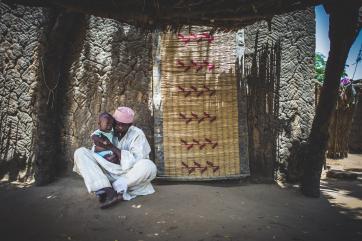
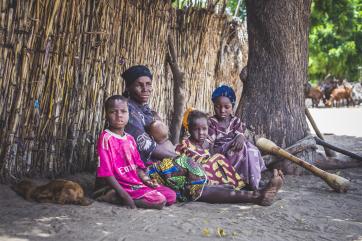
It’s an absence felt deeply by the women left behind. Salma, a mother of five in the village of Magaria Tounkour, is working even harder to provide for her children with her husband gone. Mercy Corps has provided seeds and taught her modern farming techniques to grow more food, faster. It’s given her a great advantage to feed her children, she says. But they are still young and largely unable to help. Until her husband comes back, the responsibility of keeping them alive falls almost completely on her.
“He migrates to Zinder and when he gets a little money he comes back again,” she says. “There are a lot of difficulties. I have to go in all directions — going into the bush, getting wood, doing this and doing that — so I can get a little money to feed them.”
Yet it’s also a loss that weighs on the fathers who have to leave. Alhaj, a father of eight, has been working with Mercy Corps for four years to learn how to help his wife care for their children. He has practiced housework, cooking, cleaning, and, most touchingly, childcare. He is a tender and affectionate father, laughing as he holds his twin 1-year-old sons, Hasan and Useini, while his wife looks on from the doorway of their home.
The closer he grows to them, the harder it is for Alhaj to accept the truth of what he knows is coming. Until it rains again, he has to leave.
“There is much suffering,” he says. “I leave my farm and go to somebody else’s farm who can give me money that I can bring back to feed my family.”
Option three: Learn to adapt.
For Hajia, the hunger gap now represents a new opportunity.
Before, the only place for women to get food was from their husbands’ land. But through Mercy Corps, they discovered a simple solution to a complex problem: Families could grow more food if they had a bigger place to do it.
So a short drive from her village, in a precious, shady plot of Nigerien soil, 101 women from Hajia’s village share 20 vegetable beds Mercy Corps provided for them to farm themselves. Everything they grow is theirs, to eat or sell.
They are mothers, sisters, aunts and grandmothers, a new corps of female farmers fighting the hunger gap with babies strapped to their backs.
“We contribute in the process of feeding our family,” Hajia says. “But we also are able to sell some of our produce and we can have social ceremonies like weddings, because these ceremonies need money. We can get the money from this produce.”
Selling her produce can earn Hajia as much as £40 extra in a country where the average person earns just over £300 per year, a more than 10 per cent increase in her family’s income. That extra money is a tremendous benefit to her family and has taken some of the pressure off her husband.

“I’m happy,” Badamasi says. “It’s helped us a lot. It has done a lot to improve our lives. … Before, we had problems. We were living in difficulties. But now, things have gotten better. We have improved a lot of the parts of our lives. It works.”
In the garden, Hajia paces the long rows of lettuce for more than an hour, quietly watering the ground alongside her sister, Leza. Before they had this land, the hunger gap meant going without. It was a time of suffering, she says. Their land — and the potatoes, tomatoes and cabbage they get from it — hasn’t changed the reality of living here. The hunger gap will return, as surely as the warm spring winds will blow the rains away.
But now, when it does, she knows what to do.
“Now, we go to the garden,” she says.





